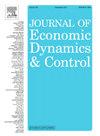金融状况、商业周期波动和增长面临风险
IF 2.3
3区 经济学
Q2 ECONOMICS
引用次数: 0
摘要
我们用经济增长的四分位数区间(波动性的稳健代理)增加了一个分位数向量自回归模型,以评估金融状况和经济风险在影响商业周期中的相对重要性。我们发现,经济风险对经济增长分布的影响是不对称的,这与金融状况非常相似:它们大幅增加了风险中的增长,但对上行潜力的影响有限。我们还发现,经济风险的不对称影响取决于经济状况,在高经济风险时期会大幅放大,而在经济平静时期则会受到抑制。本文章由计算机程序翻译,如有差异,请以英文原文为准。
Financial conditions, business cycle fluctuations and growth-at-risk
We augment a quantile vector autoregressive model with the interquartile range of economic growth, a robust proxy for volatility, to assess the relative importance of financial conditions and economic risk in affecting the business cycle. We find that economic risk displays an asymmetric effect on economic growth distribution, very much similar to financial conditions: they substantially increase growth-at-risk, but have limited impact on upside potential. We also document that the asymmetric impact of economic risk depends on the state of the economy and is substantially amplified in times of high economic risk, while remaining subdued in tranquil times.
求助全文
通过发布文献求助,成功后即可免费获取论文全文。
去求助
来源期刊

Journal of Economic Dynamics & Control
ECONOMICS-
CiteScore
3.10
自引率
10.50%
发文量
199
期刊介绍:
The journal provides an outlet for publication of research concerning all theoretical and empirical aspects of economic dynamics and control as well as the development and use of computational methods in economics and finance. Contributions regarding computational methods may include, but are not restricted to, artificial intelligence, databases, decision support systems, genetic algorithms, modelling languages, neural networks, numerical algorithms for optimization, control and equilibria, parallel computing and qualitative reasoning.
 求助内容:
求助内容: 应助结果提醒方式:
应助结果提醒方式:


